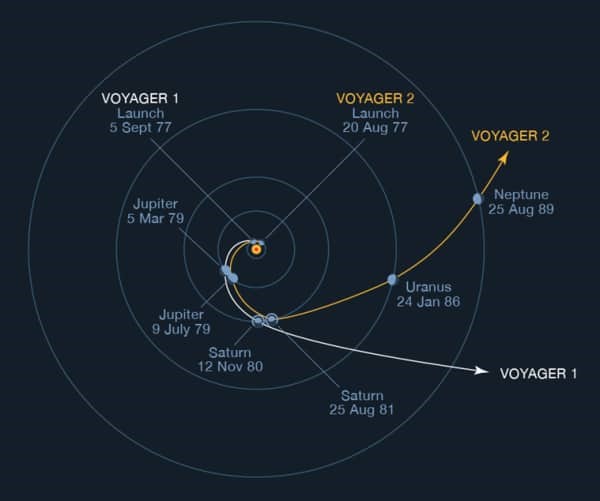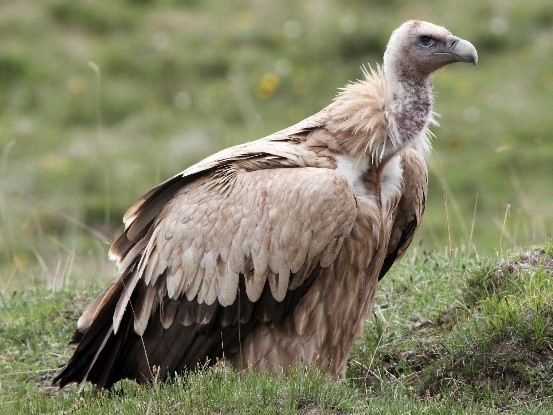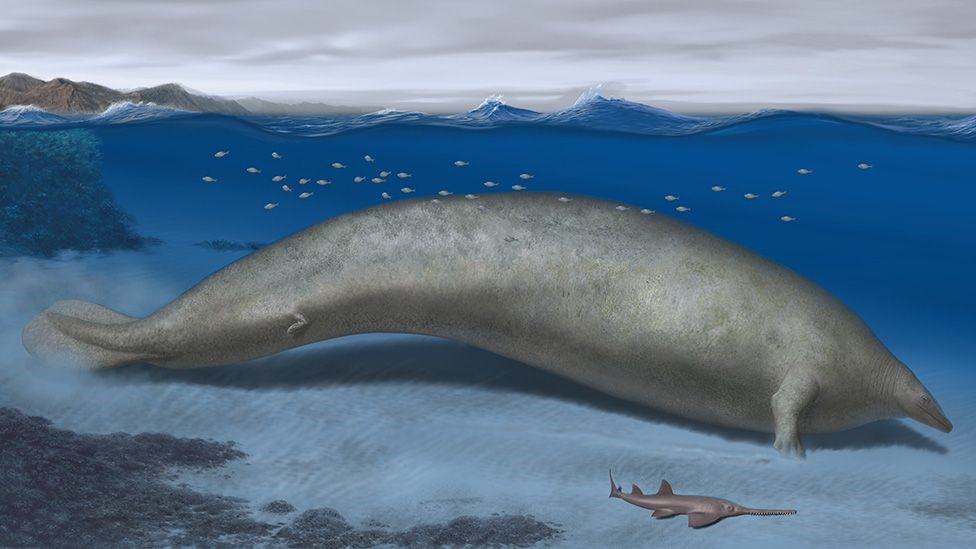Voyager Mission
More than a week after the NASA lost communication with Earth’s longest-running space probe, Voyager 2, the space agency detected a heartbeat signal from the spacecraft.
- A faulty command sent to the probe caused its antenna to point 2 degrees away from Earth making it unable to transmit data back to Earth.
Voyager Mission
- The twin spacecraft Voyager I and Voyager II were launched by NASA in separate months in 1977.
- Each of them is equipped with instruments to carry out 10 different experiments.
- Instruments - Television cameras, infrared and ultraviolet sensors, magnetometers, plasma detectors, and cosmic-ray and charged-particle sensors.
- Each Voyager spacecraft is adorned with a golden phonograph record, a 12-inch disc, intended to be a sort of time capsule from Earth to any extraterrestrial life that might intercept the probes.
Voyager – 1
- Launched in 1977, sent to space about two weeks after Voyager 2.
- Voyager 1 was set on a path to reach Jupiter and Saturn, ahead of Voyager 2.
- Voyager 1 reached its first target planet, Jupiter, on 1979.
- Voyager 1 found that Io, one of Jupiter’s moons, was geologically active.
Voyager 2
- Launched in 1977, sent to space two weeks before Voyager 1.
- The spacecraft arrived at Uranus in 1986, becoming the first human-made object to fly past the aquamarine planet.
- Great Dark Spot – The spacecraft observed the Great Dark Spot.
Great Dark Spot is a huge spinning storm in the southern atmosphere of Neptune about the size of the entire Earth.
- Voyager 2 is about 19.9 billion kilometres away from Earth, is still operating.

Interstellar is the region that lies outside the impact of our Sun’s constant flow of material and magnetic field and begins just over 18 billion kilometres from the sun.
References
1. The Indian Express | The legacy of the Voyager mission
2. NASA | Voyager
3. BBC | The weird space that lies outside our Solar System
Gyps himalayensis
Researchers have recorded the first instance of captive breeding of the Himalayan vulture (Gyps himalayensis) in India at the Assam State Zoo, Guwahati.
- About - The Himalayan vulture is also known as Himalayan griffon vulture and belongs to the Accipitrade family.
- Geographical Range - Indigenous to the uplands of central Asia, ranging from Kazakhstan and Afghanistan in the west to western China and Mongolia in the east.
- Habitat - It is native to the Himalayas and the adjoining Tibetan Plateau.
- It is one of the two largest Old World vultures and true raptors.
- It is similar and sympatric species of Eurasian griffon vulture (Gyps fulvus).

- Food - The carcasses of livestock, large wild herbivores, and humans.
- Conservation Status
- IUCN Red List - Near Threatened.
- CITES - Appendix II
- Threats - In parts of Asia and Africa, the use of veterinary diclofenac has had a devastating impact on Gyps vultures especially in the lowland regions of the Indian subcontinent.
- Diclofenac, a nonsteroidal anti-inflammatory drug, causes visceral gout in vultures that have consumed contaminated carcasses ultimately resulting in renal failure.
- Conservation breeding of other vultures - The White-rumped vulture (Gyps bengalensis), Slender-billed vulture (Gyps tenuirostris), and the Indian vulture (Gyps indicus).
- The unprecedented scale and speed of declines in vulture populations has left the entire three resident Gyps vulture species categorised ‘Critically endangered’.
|
References
- The Hindu | Himalayan vulture bred in captivity
- Great Himalayan National Park | Gyps himalayensis
Communication Interoperability and Security Memorandum of Agreement (CIS-MOA)
Pakistan Cabinet approves signing of security pact with U.S.
- Aim – It is a foundational agreement that the U.S. signs with its allies and countries with which it wants to maintain close military and defence ties.
- Legal Cover – It also provides legal cover to the U.S. Department of Defence for ensuring the sale of military equipment and hardware to other countries.
- Institutional mechanism – The signing of the CIS-MOA means that the two countries are keen to maintain the institutional mechanism.
- The agreement, first signed between the Pakistan and the U.S. in October 2005 for 15 years, expired in 2020.
- The two sides have now renewed that arrangement which covers joint exercises, operations, training, basing and equipment.
- The signing of the CIS-MOA indicates that the U.S. might sell some military hardware to Pakistan in coming years.
A cypher is a secret document that ambassadors in another country send to their country.
References
1. The Hindu | Pakistan Cabinet approves signing of security pact with U.S.
2. ANI news | Pakistan gives nod to security pact with US: Report
3. The Week | Pak Cabinet approves signing of security pact with US
Study in India (SII) Portal
The Education and Skill Development & Entrepreneurship and the External Affairs Minister jointly launched Study in India Portal.
Study in India Programme
- Ministry - It is a flagship project introduced by the Ministry of Education (MoE).
- Aim – It seeks to endorse India as a prime education hub for international students by inviting them to pursue their higher education in the country.
- Partnership – The Study in India programme involves partnership with educational institutes.
- Criteria – The institutes should be fulfilling one of the following criteria:
- National Institutional Ranking Framework (NIRF) ranking (<=100).
- National Assessment and Accreditation Council (NAAC) accreditation score (>=3.01).
- Institutes of National Importance (INI).
- This ensures premier institutions being the partner to enrolling international students coming to study in India.
Study in India portal
- HEIs – It is a dedicated website that will provide comprehensive information about the Indian Higher Education Institutions (HEIs).
- The website-portal will present information about the academic facilities, research support, and related information.
- The website will illustrate academic programs covering undergraduate (UG), postgraduate (PG), Doctoral level programs, Yoga, Ayurveda, classical arts etc.
- The new website will now have the provision for students to apply in more than one institute/course of their choice.
- The new portal will provide an integrated one-stop solution for student registration and visa application process.
References
1. PIB | Launch of Study in India (SII) Portal
2. Study in India | SII
Perucetus Colossus
The fossils of Perucetus colossus were discovered in Peru, may be the heaviest discovered animal ever, even heavier than the blue whale.
- Origin - It is a colossal whale situated at Peru which is now extinct in nature.
- Habitat - Lived in shallow coastal areas.
- Organs - It has 13 vertebrae, 4 ribs and a bit of a pelvis.
- Weight - Weighed between 85 and 340 tonnes.
- The skeletal mass of P. colossus would have been between 5 and 8 tons, which is twice that of the blue whale.
- There is no record of the existence of an animal as large as this Perucetus colossus.

- Pachyosteosclerosis – The animal’s bones had an unusually large volume and were also extremely dense, this combination of thickening and densification of bones is called pachyosteosclerosis.
- The characteristic is absent in living whales, dolphins and porpoise.
- However, it is present in sirenians, a marine mammal group that includes sea cows.
References
1. The Indian Express | Newly-discovered extinct whale
2. NDTV | Animal That Lived Nearly 40 Million Years Ago
3. BBC | Peruvian fossil challenges blue whales


